As a lover of the great outdoors and a seasoned kayaker, I know firsthand the feeling of freedom and adventure that comes from gliding across the water. The journey all begins with one essential skill that every kayaker must master – launching your kayak from shore. Launching a kayak may seem as simple as pushing off and hopping in, but there’s more to it than meets the eye.
With a combination of the right preparation, technique, and safety awareness, you’ll ensure a smooth and seamless transition from the beach to the open water. In this ultimate guide, I will provide valuable insights, tips, and a step-by-step process to help you launch your kayak with ease and confidence. So grab your paddle, strap on your life jacket, and let’s get started on this exciting journey!
Contents
Contents
Preparing Your Kayak For Launch From Shore
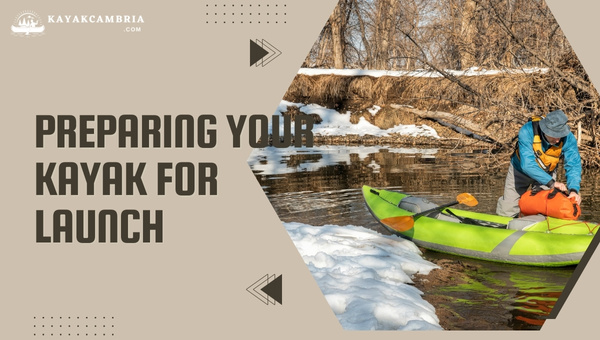
Before heading out on the water, there are several essential steps to ensure a successful and safe kayaking adventure. I’ve learned from experience that careful preparation makes all the difference in the world.
Choosing An Appropriate Launch Site
Select a suitable location with a gentle slope, good accessibility, and close proximity to the water. The ideal spot should allow you to enter the water smoothly and safely, without having to carry your kayak over substantial distances or deal with difficult terrain.
Transporting Your Kayak To The Shore
Getting your kayak from your vehicle to the launch site can be a bit of a workout, but it doesn’t have to be a struggle. I prefer to use a kayak cart for longer distances, but for shorter carries, I simply lift my kayak and carry it on my shoulder.
Performing A Safety Check
Before launching, it’s essential to check that all the necessary safety equipment is in order. Ensure your grab lines are secure, your gear is fastened and protected, and all paddlers have Personal Flotation Devices (PFDs) that are the right size and in good condition.
Loading Your Gear Securely And Balanced
Loading your kayak properly ensures that it remains stable and maneuverable in the water. Distribute the weight evenly between the bow and stern, securing all gear in waterproof bags or containers. It’s also a good idea to use bungee cords or straps to secure your equipment and prevent it from shifting around as you paddle.
Getting Ready To Launch A Kayak From Shore
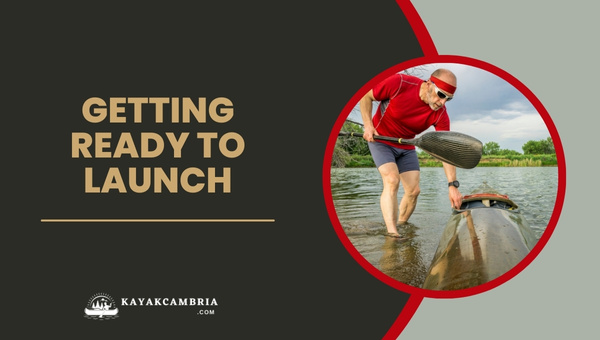
Before setting off on your kayaking adventure, it’s essential to prepare both yourself and your gear for a smooth launch. Wearing the right clothing is crucial – you should dress appropriately for the water conditions. For example, you might choose to wear a wetsuit or drysuit if the water is colder, or opt for quick-drying and breathable materials if it’s hot. Don’t forget your water shoes for added grip and comfort during the launch!
A properly fitted Personal Flotation Device (PFD) should always be worn while kayaking. Make sure it is snug and secure with all straps and buckles fastened. Remember, a PFD can save your life in case of a capsize, and it’s required by law in most areas.
Next, you’ll want to prepare your paddle. Adjust its length according to your height and the type of kayak you have. Verify that the blades are angled correctly, usually with a slight offset. Familiarize yourself with the various paddle strokes, such as the forward stroke, backward stroke, sweep stroke, and draw stroke which you’ll use to control your kayak and navigate the waters effectively.
By taking the time to thoughtfully get ready, you’ll be more confident, comfortable, and prepared to enjoy a fantastic day out on the water.
The Perfect Technique For Entering Your Kayak
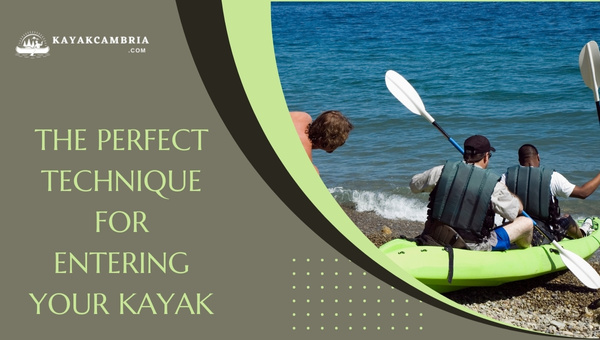
Entering your kayak correctly is essential for a smooth and safe launch. With practice, you’ll find the right technique that feels comfortable and works best for you. Here’s a step-by-step guide to help you perfect your entry technique.
- Position your kayak on the shoreline: Place your kayak parallel to the shore with the nose slightly pointing away from the shore. Make sure the kayak is stable and doesn’t wobble. Depending on the type of shore, it might help to place the kayak on a small cushion of sand, grass, or a towel to prevent it from sliding.
- Use your paddle to stabilize: Place the paddle on the ground behind the cockpit with one end touching the ground and the other end on the opposite side of the kayak. Hold onto the paddle shaft with the hand closest to the shore to create a stabilizing outrigger.
- Entering the kayak: Start by placing one foot in the cockpit while keeping your weight low. Make sure your foot is well-grounded for balance. Maintaining a firm grip on the paddle, lower yourself into the seat. Try to sit promptly yet gently, keeping your movements controlled and steady.
- Adjust your foot pegs and backrest for comfort: Once you’re seated, check your foot pegs and backrest to ensure they’re adjusted correctly for your leg length and comfort. A proper fit will provide you with better paddling efficiency and overall control of your kayak.
By mastering these steps, you’ll have a smooth and efficient way to enter your kayak each time you head out on the water. Remember that practice makes perfect, so don’t be discouraged if it takes a few tries to get it right. As you gain experience, you’ll develop a seamless technique that works best for your specific kayak and personal comfort.
Launching Your Kayak From Shore
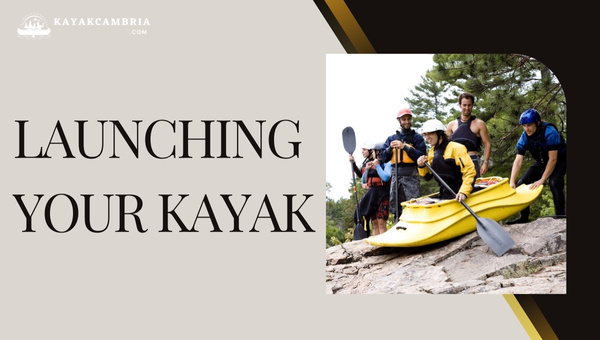
Now that you’re all set and ready to launch, it’s time for the exciting part of your adventure. Learning to launch your kayak effectively is an essential skill for a fun and safe paddling experience. Follow these steps to ensure a smooth entry into the water:
- Push off from the shore: First, make sure your kayak is facing the right direction, with the nose pointing away from the shore. While balancing yourself in the kayak, use your paddle to push off, ensuring that you maintain stability by holding the paddle in a comfortable grip.
- Paddle away from obstacles: As you move away from the shore, watch for any rocks or debris in the water. Use your paddle to steer around these obstacles and navigate the shallow waters near the shoreline. Remember to keep an eye out for other watercraft, swimmers, and animals too.
- Understand basic kayaking strokes: To successfully start paddling, you’ll need to utilize basic kayaking strokes to control your kayak’s movement. Master the forward stroke to propel yourself straight ahead, practice the backward stroke for reverse movement, and use the sweep and draw strokes to turn and maneuver in tight spaces.
You’ve successfully launched your kayak from the shore and are now ready to explore the open waters. As you become more experienced, you’ll find that launching your kayak will become second nature, setting you up for many future adventures on the water.
Understanding Kayak Types And Their Launch Techniques
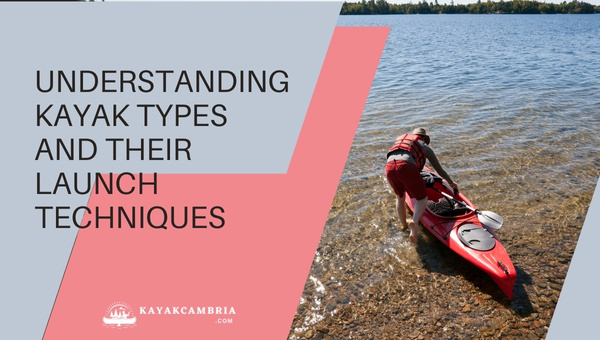
When it comes to launching a kayak, understanding the differences between the various types of kayaks can make all the difference. Sit-on-top, sit-inside, and inflatable kayaks each have their distinct characteristics, and launching them from shore requires some adaptability in your technique. Here, I’ll break down the different types of kayaks and highlight tips for launching each one successfully.
Sit-on-Top Kayaks

These popular kayaks feature an open cockpit, making them easy to board and launch. Their stability and user-friendliness make them a favorite for beginners or those looking for recreational fun on the water.
- When launching a sit-on-top kayak, the key is to keep your center of gravity low. Begin by straddling the kayak, then sit down on the seat and smoothly swing your legs into the cockpit.
- Stabilize the kayak using your paddle, placing it perpendicular to the kayak with one blade resting on the shoreline.
- Lastly, push off from the shore using your paddle or hands to kick-start your journey on the water.
Sit-inside Kayaks

Sit-inside kayaks have a more enclosed cockpit and are a popular choice for touring or sea kayaking. These kayaks offer better protection from the elements and can be a bit trickier to launch than their sit-on-top counterparts.
- To launch a sit-inside kayak, angle the bow away from the shore, and stabilize the kayak with your paddle as mentioned above.
- Squat with your back facing the water, then place one foot inside the cockpit and sit down, extending your other leg, and sliding it in.
- Once you have your feet placed on the foot pegs, adjust your backrest as needed before moving away from the shore.
Inflatable Kayaks

Inflatable kayaks have grown in popularity due to their portability, affordability, and ease of storage. Their soft, buoyant material introduces some nuances in the launching process.
- Once you’ve inflated your kayak, place it on the shore and stabilize it with your paddle, similar to the sit-inside kayak technique.
- Instead of sitting down abruptly, gently make your way into the seat to avoid damaging the padding or puncturing the inflatable.
- Be cautious when propelling yourself off the shore, as sharp rocks or debris on the shoreline can cause damage to your inflatable kayak.
By understanding the differences between the various kayak types and adapting your launch technique, you’ll be a master at launching your kayak from shore in no time.
Importance Of Effective Communication
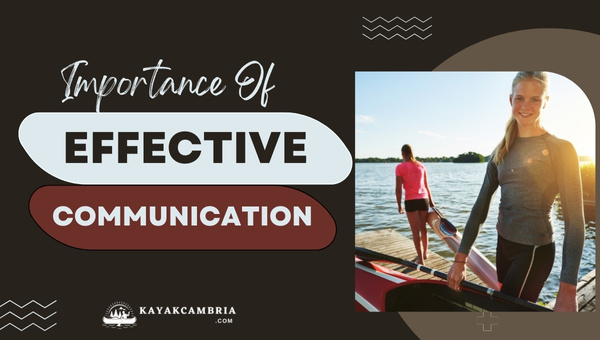
When preparing for any kayaking adventure, effective communication is essential to ensure everyone’s safety and to create a smooth experience. Whether you’re launching from the shore with one buddy or as part of a group, coordinating your efforts and understanding each other’s intentions will make the process much easier and more enjoyable for all. Here are some critical aspects of communication to consider when launching your kayak:
Pre-launch Communication With Your Paddling Buddy Or Group
Before hitting the water, it’s crucial to establish a clear plan and discuss any concerns or potential challenges with your paddling partners. You can also divide responsibilities among group members, such as one person holding the kayaks while others load gear or put on their PFDs.
Proper Use Of Hand Signals And Audible Cues When Launching
To prevent confusion and accidents during the launch, having a common set of hand signals and audible cues can help maintain order and ensure everyone is on the same page. Make sure everyone in your group is familiar with these signals, and practice them before setting out.
Examples of hand signals:
- Pointing with a raised paddle to indicate the direction
- Tapping the side of the kayak to signal stop or hold the position
- Paddle above head in a waving motion to signal help or assistance needed
Examples of audible cues:
- “Ready?” – asking if everyone is prepared to launch
- “Push off!” – signaling to begin moving away from the shore
- “Paddle!” – encouraging everyone to use their paddles to propel forward
Coordinating A Successful Launch Under Challenging Conditions
Sometimes the weather or water conditions during a kayak launch can be more challenging than expected. In these instances, the importance of effective communication is heightened even further. Stay calm and focus on keeping everyone informed about any impending hazards or obstacles that might impede the launch, and work together as a team to overcome them.
Remember, launching your kayak from shore is a skill that requires both practice and adaptability. Emphasizing effective communication will not only make the process more manageable but also create a strong foundation for a safe and enjoyable day out on the water.
Proper Etiquette For Launching In Crowded Areas
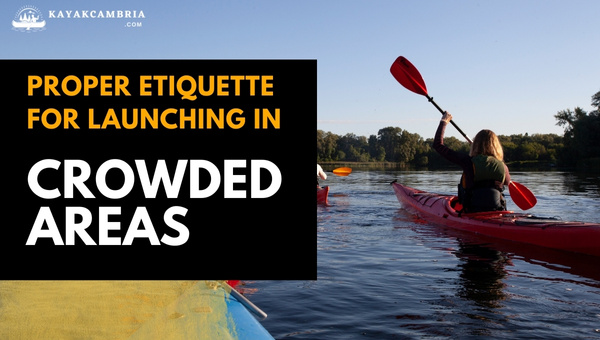
Regardless of whether you are a seasoned kayak enthusiast or a newbie to the sport, showing proper etiquette during a kayak launch is always important, especially in crowded areas. Practicing good manners makes the launch experience more enjoyable, safer, and smoother for everyone involved. Let me share some key tips on how everyone can paddle courteously in a busy launch spot.
Respect Other Kayakers And Watercraft Users
As a general rule, treat other water enthusiasts with the same respect and courtesy you would like to receive. Always be aware of how your behavior impacts others and respect their personal space. Also, be ready to aid others if needed, be it helping them carry their kayak to the water or offering safety tips.
Patience During Peak Times
Particularly during the peak season, kayak launch sites can become quite congested. It’s important to remain patient as everyone waits their turn to use the shared space. If you’re in a hurry, try to launch your kayak during off-peak hours instead.
Spatial Awareness When Launching
Take note of your surroundings and pay attention to nearby kayakers or other watercraft users. Try to anticipate their movements, and give them enough space to maneuver without interference. When you’re ready to launch, do it smoothly and efficiently to minimize any inconvenience to others.
Communicate With Fellow Paddlers
Effective communication is crucial in crowded launch situations. Use your words, hand gestures, or even a friendly smile to signal your intentions. For instance, if you need assistance or someone to clear the way for your launch, a polite request goes a long way.
Wait Your Turn
Sometimes, the launch site may not have enough space to simultaneously accommodate everyone, so we must wait our turn. Be courteous and mindful of the order in which people have arrived, and allow those who were there first to launch before you.
Avoid Blocking The Launch Area
While you wait to launch, keep your kayak and gear to the side, so the prime launch area remains clear for the next person. Blocking the path only creates more tension and delays for everyone at the site.
By following these etiquette tips, you’ll contribute to a positive and enjoyable experience at crowded kayak launch sites.
Self-Rescue Techniques And Emergency Preparedness
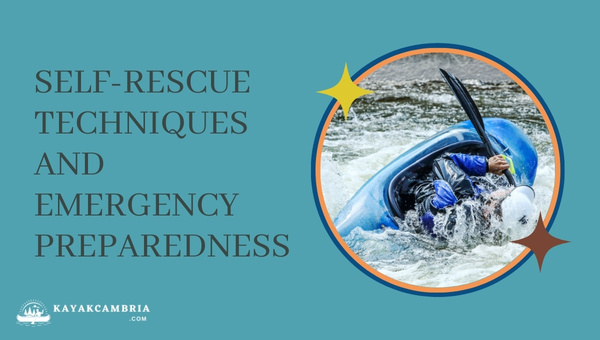
As a kayaker, I am well aware that my safety and the safety of others depend on being prepared for unexpected situations. Paddling in open water means we must anticipate potential issues and know how to react accordingly. In this section, I will share insights on self-rescue techniques and emergency preparedness when launching your kayak from shore.
Essential Rescue Gear
Before you even think about getting on the water, make sure you have the necessary rescue equipment on hand. Some of the essential items that I always have on board include:
- Paddle float: This inflatable device helps provide buoyancy when re-entering your kayak after a capsize.
- Bilge pump: Used for removing water from your cockpit in case of flooding.
- Whistle: A loud, easily accessible signaling device to attract attention in case of emergencies.
Basic Self-Rescue Techniques
It’s essential to know a few self-rescue techniques should you end up in the water. Some of the most common methods I’ve practiced are:
- Wet exit: Safely get out of your kayak when capsized or submerged. Stay calm, unbuckle your spray skirt (if using one), and push yourself out of the cockpit.
- Cowboy scramble: Climb back into your sit-on-top kayak by kicking your legs and sliding your body onto the kayak from the rear deck.
- Paddle float reentry: Use the paddle float attached to your paddle as an outrigger for added stability while pulling yourself back into the cockpit.
First Aid Kit And Signaling Device
As a responsible paddler, I always carry a well-stocked first aid kit. Accidents can happen, and it’s better to be prepared for any injuries or medical emergencies that might occur while on the water. I recommend including items such as bandages, gauze, adhesive tape, antiseptic wipes, pain relievers, and any personal medications.
Additionally, having a reliable signaling device, such as a whistle or an air horn, will help you alert others if you need assistance on the water.
By staying vigilant and prepared, we can help ensure a safe kayaking experience for ourselves and our paddling companions.
Planning And Preparing For Long-distance Launches
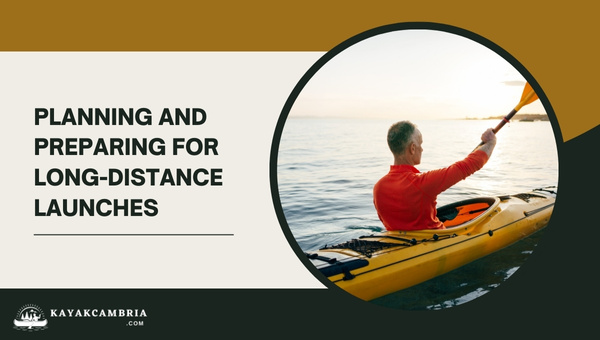
Just as with any outdoor adventure, preparation is key when planning to launch your kayak for a long-distance journey. From researching your route to staying fueled throughout the trip, I’ve learned the importance of foresight and readiness. Here’s a breakdown of what you should consider before embarking on an extended kayak trip.
Research Your Route
Before you hit the water, take the time to investigate your planned route. Evaluate the distance, water conditions, possible obstacles, and any relevant weather patterns to best anticipate any challenges you may face. Make sure to also check for any marine traffic or restrictions in the area. Having a well-defined route will save you time and provide a safer exploratory experience.
Prepare For The Unexpected
When it comes to long-distance kayaking, it’s crucial to be prepared for the unexpected. Always carry a well-stocked first aid kit, proper signaling devices, and suitable rescue gear. Be sure to have a backup plan in case your journey takes an unexpected turn.
For a successful long-distance kayak launch, invest in developing your navigation skills. Practice using a compass, GPS, and relying on natural landmarks to ensure you’re on the right path. Proper navigation helps keep you on course and prevents unplanned detours or delays.
Hydration And Nutrition
Staying hydrated and fueled is particularly important during long-distance kayaking trips. Pack enough water and nutritious meals or snacks to maintain your energy levels throughout your adventure. Consider using a hydration system with a hands-free drinking hose, allowing you to stay refreshed while keeping both hands on your paddle.
Layer Your Clothing
Long-distance kayaking often means spending extended periods in various weather conditions. Dress in layers with moisture-wicking, quick-drying materials to stay comfortable on the water. Pack extra clothing in a waterproof bag in case temperatures drop or you need to change out of wet garments.
By staying organized and planning ahead, you’re more likely to have a successful, enjoyable long-distance kayak launch. As always, remain vigilant, prioritize your safety, and remember to take in the beauty of your surroundings throughout your kayaking journey.
Kayak Launching And Environmental Stewardship
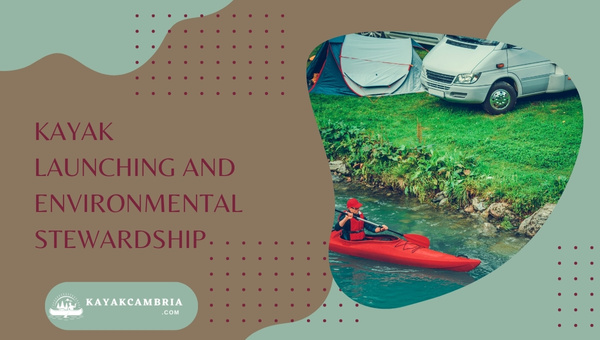
One of the most important aspects of kayaking is taking care to protect the natural environment when launching and paddling. By practicing good stewardship, we not only enjoy our time on the water but also contribute to the preservation of these beautiful ecosystems for future generations. In this section, I will discuss some essential principles and tips for protecting the environment while launching your kayak.
Leave No Trace Principles
When going out for a kayaking adventure, always follow the “Leave No Trace” principles. These guidelines help outdoor enthusiasts minimize their impact on the environment and preserve it for others to enjoy. Key principles include:
- Plan ahead and prepare: Know the regulations and potential hazards of the area you plan to visit. Prepare for changing weather and emergencies by bringing appropriate gear.
- Travel and camp on durable surfaces: Stick to established launch sites and paths to prevent erosion and damaging vegetation.
- Dispose of waste properly: Pack out all trash, leftover food, and litter. Do not dump any waste in the water, including gray water from washing dishes or hands.
- Leave what you find: Observe, but do not disturb, natural and cultural features such as plants, animals, and historical structures. Avoid picking plants or removing rocks.
- Minimize campfire impact: Use a portable stove for cooking and avoid creating new fire rings. If fires are permitted, opt for a small, controlled fire. Keep fires small and burn only small sticks using established fire pans or fire rings, if available.
- Respect wildlife: Maintain a safe distance from animals and never feed them. Securing your food and trash helps prevent wildlife from becoming accustomed to human food.
- Be considerate of other visitors: Keep noise levels low and respect other users’ privacy. Share launch sites and coastal spaces courteously.
Protecting Wildlife Habitats
When launching and landing your kayak, take care to protect sensitive shoreline habitats. Many coastal areas are home to birds, fish, and other wildlife that rely on the shoreline for nesting and spawning. To minimize your impact on these habitats:
- Avoid landing on vegetated shorelines or areas with visible nesting activity.
- Maintain a respectful distance from wildlife and do not disturb them with excessive noise or sudden movements.
- Learn about seasonal closures or restricted areas aimed at protecting sensitive wildlife and habitats, and respect any posted signs or guidelines.
Responsible for Gear Care And Disposal
Taking care of your kayak gear poses an environmental responsibility as well. Follow these tips to keep your gear in good condition while also being a responsible steward of the environment:
- Clean your kayak and gear regularly to avoid transferring invasive species or contaminants between bodies of water. Use mild, biodegradable soap and scrub down your gear with a soft brush.
- Inspect and repair your gear regularly to minimize waste. Fix any minor damage or leaks to prolong the life of your equipment.
- Responsibly dispose of worn-out gear or consider recycling or donating items that can still be used by others.
- Use reusable water bottles and food containers to reduce single-use plastics during your kayaking trips.
By following these principles and tips, you can ensure a positive and responsible kayaking experience that respects the environment and allows us to continue enjoying the great outdoors for years to come.
Common Mistakes And Troubleshooting
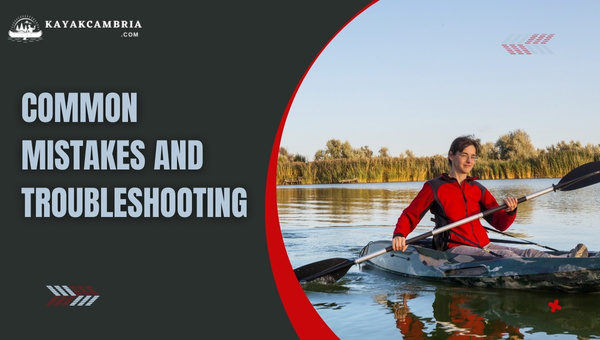
A smooth launch is key to a great kayaking trip. But despite our best efforts, sometimes mishaps occur. Here, I’ll share the common mistakes I’ve encountered and how to troubleshoot them.
Overcoming The Fear Of Capsizing
Capsize anxiety is perfectly normal, but kayaks are designed to be stable when paddled correctly and in suitable conditions. To help ease your fears, practice capsizing and re-entering your kayak in a controlled environment, like a calm lake or pool with a buddy. This will help you build your confidence and skills needed for real-life situations.
Dealing With Windy Or Wavy Launches
Launching in windy or wavy conditions can be challenging. To minimize this issue, check the weather and wind conditions before you go, and choose a launch site with natural protection like a cove or leeward side of an island. If you must launch in such conditions, make sure to paddle into the wind at a slight downwind angle, and brace yourself with your paddle when the waves impact your kayak.
What To Do If You Get Stuck In Shallow Waters
If your kayak becomes stuck in shallow water, don’t panic. First, try to back paddle gently to free your kayak. If that doesn’t work, use your paddle as a lever to push off nearby rocks or the ground. As a last resort, you may need to exit your kayak and carefully walk it to deeper waters, ensuring you do not disturb marine life.
How To Get Back In If You Fall Out
Falling out of your kayak can be a scary experience. If you find yourself in the water unexpectedly, remain calm and keep hold of your paddle. Start by swimming your kayak to a shallow area where you can safely stand. Next, flip your kayak upright and empty any water using a bilge pump or by lifting one end of the kayak. Once it’s drained, re-enter your kayak using techniques like the cowboy scramble or paddle float reentry.
By learning from these common mistakes and troubleshooting tips, you’ll become a more skilled kayaker, adapt to various situations, and enjoy your time on the water even more.
Additional Launch Prep Tips
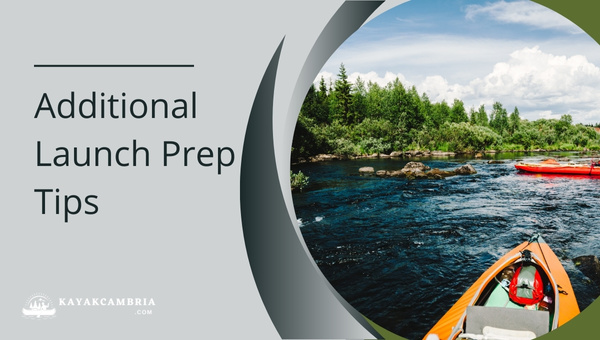
Before you hit the water, take a moment to embrace these extra launch preparation tips, ensuring a successful and enjoyable kayaking adventure.
Pack A Waterproof Bag For Essentials
Bring along a waterproof bag to keep your essentials safe and dry. This includes your phone, keys, snacks, and any other valuable items you might need while out on the water. Remember to pack light, though – you don’t want to weigh down your kayak with unnecessary gear.
Check For Marine Traffic And Restrictions
Before you launch, familiarize yourself with any local marine traffic and restrictions in the area. This includes checking for other kayakers, swimmers, motorized boats, and any temporary or permanent restrictions that might impact your course. Knowing what to expect can help you choose the safest route and avoid any conflicts on the water.
Italics – Being informed about your surroundings will ensure a safer and more enjoyable paddling experience.
Proper Warm-up And Stretch Exercises
Like any physical activity, it’s essential to prepare your body for kayaking by warming up and stretching. Focus on stretching your arms, shoulders, back, and core, as these muscles will be heavily used during paddling. A light warm-up and stretching routine can help prevent injury and improve your overall stamina on the water.
Know The Local Tides And Weather Conditions
Lastly, always check local tides and weather conditions before launching your kayak. Tidal changes can significantly impact both the water level and shoreline conditions, so it’s crucial to plan your launch time accordingly. Meanwhile, knowing the day’s forecast can help you appropriately dress for the water temperature and avoid getting caught in severe weather. Keep a reliable weather app or website on hand for real-time updates.
By considering these additional launch preparation tips, you’ll be well-equipped to tackle any challenge during your kayaking adventure.
Returning To Shore
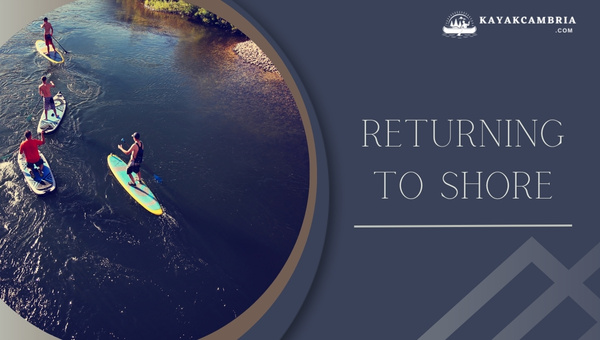
After a day of exploring and enjoying the water, it’s time to head back to the shore and land your kayak gracefully. This process may require some practice, but you’ll soon become an expert at navigating the return to your launch point. Here’s what you should expect and do when returning to shore.
Make sure to consider the wind, currents, and any landmarks that may help you locate your original launch spot. If you struggle with this step, it’s helpful to have a GPS device or a navigation app on your phone to guide you back more easily.
Landing Your Kayak Gracefully
As you approach the shore, make sure your kayak is parallel to the shoreline to avoid tipping or getting stuck. Pay attention to the timing of the waves if you’re at a beach launch. Wait for the right moment when a wave isn’t carrying your kayak in too quickly, and then use your paddle to move forward and glide onto the shore.
Stepping Out Safely
To step out of your kayak, first stabilize yourself by placing your paddle across the kayak behind the cockpit. Keep one hand on the paddle and use the other hand to support your weight as you step out cautiously. Be mindful of slippery or rocky surfaces while stepping out and always keep a low center of gravity to maintain balance.
Securing Your Kayak And Unloading Your Gear
Once you’re safely onshore, drag or carry your kayak away from the water, and safely secure it to prevent it from blowing away or drifting off. Remove any gear you stored on your kayak and check that no items have fallen overboard. It’s essential to keep the area clean and leave it as you found it to minimize your impact on the environment.
Now that your kayak is back on shore, give yourself a pat on the back for a successful return. And remember, practice makes perfect – the more you practice launching and landing your kayak, the more efficient and enjoyable the process will become.
Capture Your Kayaking Memories
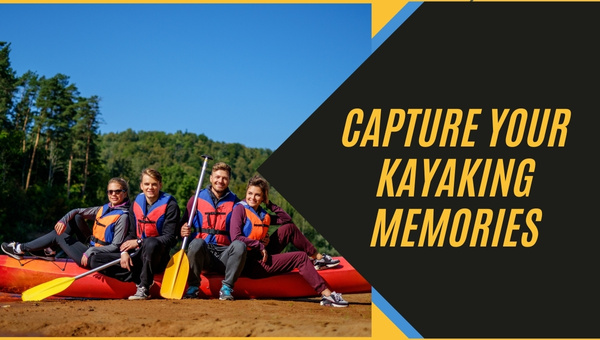
There’s no better way to remember your kayaking adventures than by capturing the breathtaking moments you experience on the water. Not only do these memories serve as personal mementos, but they also allow you to share your experiences with friends, family, and fellow paddlers. Here are some tips for documenting your kayaking trips safely and beautifully while respecting the environment.
Choosing The Right Equipment
- Camera: A waterproof camera or action cam (such as GoPro) is perfect for capturing your kayaking moments without worrying about water damage.
- Waterproof phone case: If you’re using your smartphone as a camera, invest in a waterproof case to protect it while on the water.
- Mounts and straps: Consider using mounts or straps to secure your camera to your kayak, paddle, or PFD. This ensures your camera stays put and is always within reach.
Safety Considerations
- Keep your focus on paddling: Always prioritize your safety and focus on paddling during launches and while on the water. Don’t let capturing images or video distract you from maneuvering your kayak safely.
- Keep camera gear secure: Make sure your camera is securely attached to your person or kayak using tethers or straps at all times to avoid losing it in the water.
- Practice using your gear: Familiarize yourself with the features and settings of your camera equipment before getting on the water. This will enable you to capture stunning shots quickly, without compromising your safety.
Respecting The Environment While Capturing Memories
- Leave No Trace: As you document your kayaking adventures, always adhere to the Leave No Trace principles. Stay on designated paths when taking photos from shore, and be mindful of protecting the delicate ecosystem around you.
- Respect wildlife: Keep a safe distance from wildlife while capturing images or video, avoid disturbing their natural habitats or behaviors.
- Frame your shots: Frame your photos in a way that excludes trash or any other human-made objects, encouraging environmental respect in your images.
Tips For Beautiful Shots
- Use the natural light: Utilize the golden hours (early morning and late afternoon) for the most stunning lighting conditions.
- Capture the action: Take candid action shots of you and your companions paddling, exploring the shorelines, and enjoying the natural surroundings.
- Seize the moment: Sometimes, the most memorable images come from unexpected moments. Keep your camera ready to capture candid experiences on your kayaking trip.
Capturing your kayaking memories allows you to relive your adventures and share the beauty of your journey with others. By taking extra care with your photography equipment and remaining mindful of the environment and safety, you’ll preserve not only your memories but also the wonder of the world around you.
Frequently Asked Questions
1. Is it necessary to wear a Personal Flotation Device (PFD) while kayaking?
Absolutely! Wearing a properly fitted PFD is crucial for your safety while on the water. Even if you are a strong swimmer, unexpected situations can occur, and a PFD will provide crucial buoyancy and support in case of an emergency.
2. What is the best type of kayak for beginners?
Sit-on-top kayaks are often recommended for beginners, as they are more stable and easier to maneuver than sit-inside kayaks. They also provide a more open and comfortable seating area, as well as a self-bailing design that helps prevent water from filling the cockpit.
3. How do I choose the right paddle size?
Your paddle selection depends on your height, kayak width, and paddling style. A proper paddle size helps improve efficiency, and comfort, and reduces the risk of injury. To find the suitable length, stand the paddle vertically next to you — the top grip should be at your wrist when you raise your arm above your head.
4. Do I need to know specific kayaking skills before launching from shore?
Knowing basic paddle stroke techniques – forward, backward, sweep, and draw – will help you better control your kayak during launching and paddling. Familiarizing yourself with self-rescue techniques can also be useful in case of emergencies.
5. What should I keep in my waterproof bag during a kayaking trip?
Essential items include a spare set of clothes, snacks, drinking water, a small first-aid kit, and your phone and keys in a waterproof case. Other items such as a map, compass, GPS device, sunscreen, insect repellent, and a hat can also be useful.
6. How can I ensure that I am respecting the environment while kayaking?
Follow the “Leave No Trace” principles by minimizing your impact on the environment. Avoid disturbing local wildlife, pack out all trash, stay on designated paths, and properly clean and dispose of human waste.
7. Can I launch my kayak in a crowded area?
Yes, but be respectful and courteous to other watercraft users. Wait your turn, give other kayakers ample space, and avoid blocking the launch area unnecessarily. Cooperation and good communication are key in such situations.
8. How can I improve my balance and stability while launching my kayak?
Practice entering and exiting your kayak on dry land or shallow water to build confidence and muscle memory. Keep a low center of gravity and use your paddle to help stabilize yourself during the launch. With time and experience, you’ll be able to maintain better balance and stability on the water.
Conclusion
Learning how to launch a kayak from shore is an essential skill that every kayaker should master. From selecting the right location to learning the proper techniques for pushing off, each step is crucial to making your kayaking experience a safe and enjoyable one. By following the tips and tricks shared in this guide, not only will you be well-prepared for any challenges you may face, but you’ll also be able to enjoy your time on the water with confidence.
Remember to always be a responsible kayaker, consider the environment, and be courteous to others at the launch site. Equipped with this knowledge, you’re now ready to take on the adventure of a lifetime.

